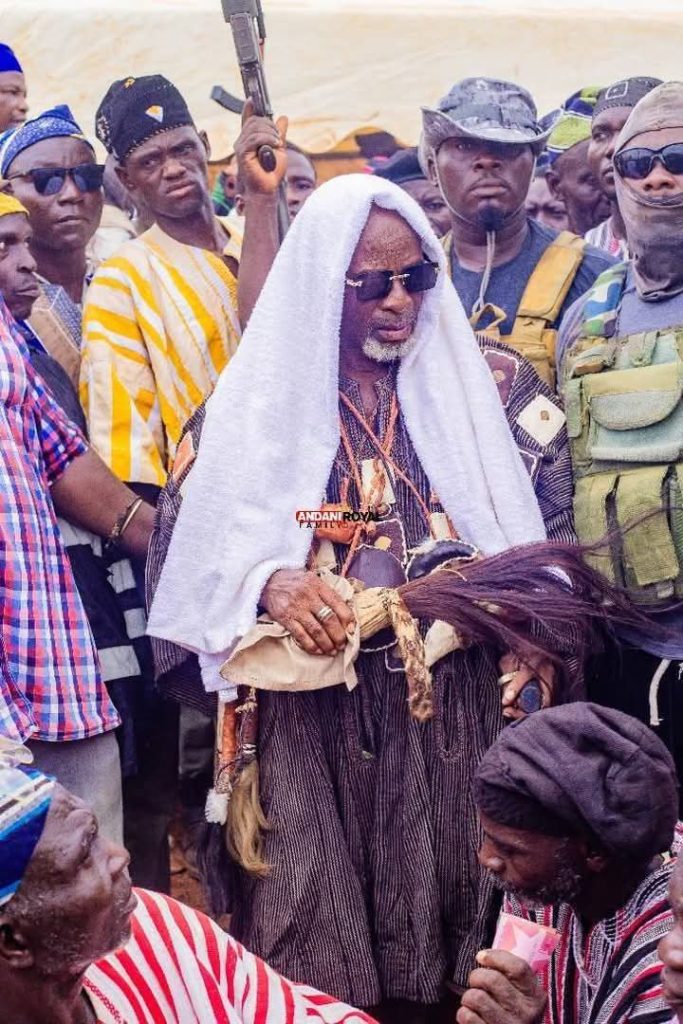By Issifu Alidu Laa-Bandow
Contributing Writer: ʒii Tuya Naa Mohammed Baba
Tamale, Dagbon – June 3, 2025
In a defining moment for the Dagbon Kingdom, His Majesty Ya-Na Abukari II, King of Dagbon, has officially enskinned Demong Kutun Naa as the new Mionlana—Paramount Chief of the Mion Traditional Area. The enskinment ceremony, conducted with grandeur and deep reverence at the Gbewaa Palace in Yendi, ushers in a new chapter for one of the most historically symbolic and strategically important chieftaincy positions in Dagbon.
This significant royal act elevates Mionlana Alhassan II to one of the two gateway skins to the Yendi Skin—the apex of traditional authority in Dagbon. His enskinment by the Ya-Na not only fulfills the customary rites of succession but also reaffirms Dagbon’s enduring legacy of orderly royal transitions, lineage dignity, and ancestral legitimacy.
“This is a day our ancestors would be proud of,” remarked ʒii Tuya Naa Mohammed Baba, cultural documentarian and contributor. “The royal flame has passed into worthy hands.”
A Rite Beyond Cola—An Authority Reborn
Prior to this formal enskinment, Demong Kutun Naa had earlier received the sacred presentation of cola, symbolizing royal nomination and the Ya-Na’s trust. While the sacred cola signals endorsement, it is the enskinment itself that confers full legitimacy and authority—a moment steeped in ancestral invocation and royal affirmation.
Born in January 1952 in Yendi, Mionlana Alhassan II is the son of Ya-Na Mahama Bla (reigned 1948–1953) and Napaɣa Sanatu Paɣakaba, who hails from the N Yaba Yiri warrior house—one of Dagbon’s most esteemed matrilineal lineages.
Statistically, he is the fourth biological son of Ya-Na Mahama Bla. The eldest, Yaa-Naa Abdulai ŋmarigɔŋ, ruled from 1954 to 1967. The second was Nasa-Lana Naantɔɣimah, followed by Nabiyɔŋ Suɣiri. Today, three sons of Ya-Na Mahama Bla are still living: Mionlana Alhassan II, Nabiyɔŋ Andani Mahama, and Nabiyɔŋ Ziŋ-Naa Alhassan. Additionally, four royal princesses from this line remain, representing Dagbon’s living dynastic continuity.

Following the death of his father in 1953, the young prince and his mother were customarily returned to her natal home at N Yaba Yiri, where they were nurtured by maternal kin. It was here that the young Alhassan’s character and values were shaped—rooted deeply in the heritage of warriors, oral history, and communal strength.
His maternal descent is traced to the illustrious Achiri Damba, a legendary warrior immortalized in Dagbon oral history as:
“Sapaɣa yi dimma di so tinŋmari dimbu dama tinŋmari ka galiga”
(“The warrior who led by courage, guided the youth with discipline, and guarded the realm with dignity.”)
Achiri Damba fought side-by-side with Kambon-Nakpɛm Ziblim in the pivotal Battle of Adibo on December 4, 1896, valiantly defending Dagbon against British colonial forces. From Achiri Damba descended Kaluɣu Musah, followed by Wumbei and Neindoo, then Jahinfo Jɛrigu—who served as Yani Jahinfo during the reign of Ya-Na Abudu Satankuɣili (1920–1938). Jahinfo Jɛrigu fathered N Yaba Kojo, who gave birth to N Yaba Yiri, the mother of Napaɣa Sanatu Paɣakaba, and thus grandmother to Mionlana Alhassan II.
This dual inheritance of royal paternity and warrior matriliny uniquely positions Mionlana Alhassan II as a symbol of both political legitimacy and ancestral valor.
Mionlana Alhassan II’s life journey reflects a profound commitment to public service and community development. He began formal education in 1960 at Yendi Primary School, and by 1970, he was among the pioneering class of Yendi Secondary School—a class that included future national figures such as Dr. Abu Sakara, Hon. Mustapha Ali, and Naa Bapra Kpan-Naa Abukari Abdulai.
His career began as a pupil teacher, later transitioning into agriculture where he joined the Ministry of Food and Agriculture in 1978 as a Plant Quarantine Officer. He served in Saboba, Gambaga, and Bunkpurugu, enhancing national agricultural health and border crop surveillance. He later upgraded his qualifications at the Agricultural College in Nyankpala and continued serving with integrity until his retirement in 2013.
Mionlana Alhassan II is married to three wives and is father to ten children—six sons and four daughters—as well as fifteen grandchildren. His family life, much like his public service, is rooted in the traditions of Dagbon: continuity, dignity, and moral stewardship.
Across the towns and villages of Mion and beyond, the enskinment has ignited widespread celebration, pride, and optimism. For many, Mionlana Alhassan II embodies the fusion of royal bloodline, ancestral strength, and modern wisdom.
“This is more than succession. It is the torch of our ancestors relit,” declared a respected elder from Mion. “With this enskinment, Dagbon reaffirms its spirit.”
As the ancestral drums of the Gbewaa Palace echo once more, all eyes turn to Mionlana Alhassan II—a man whose story is stitched from courage, culture, and continuity—as he assumes the sacred mantle to lead his people with peace, wisdom, and justice.
Long live Mionlana Alhassan II. Long live the Kingdom of Dagbon.
Reporter: Issifu Alidu Laa-Bandow
Photography & Cultural Documentation: ʒii Tuya Naa Mohammed Baba


